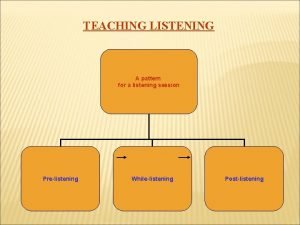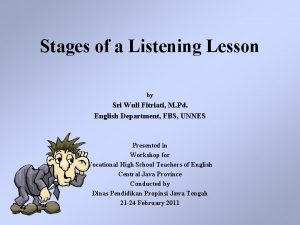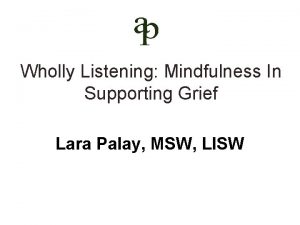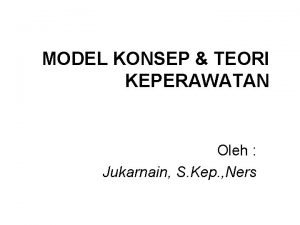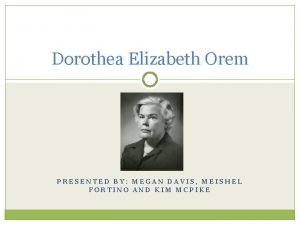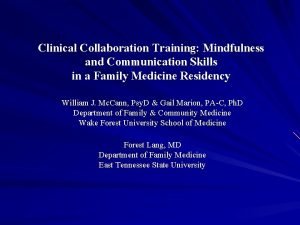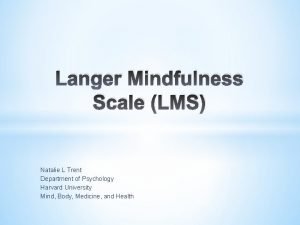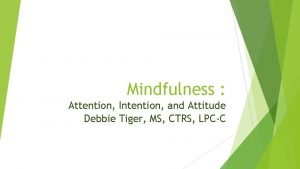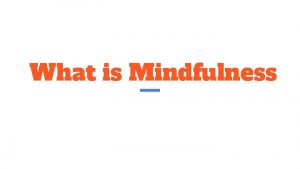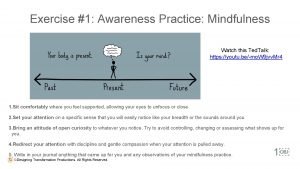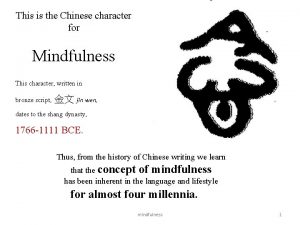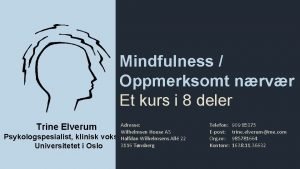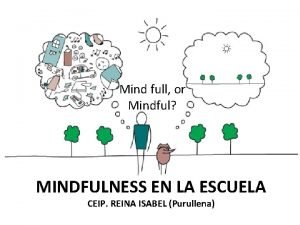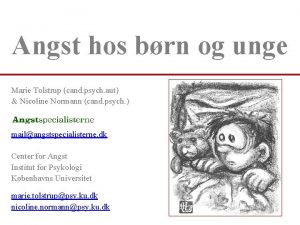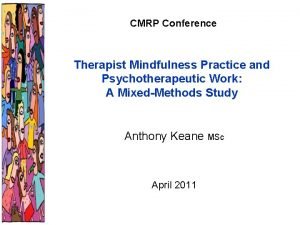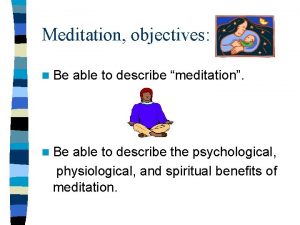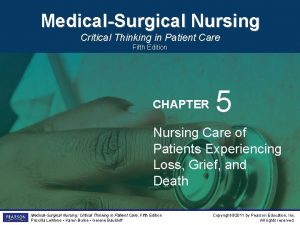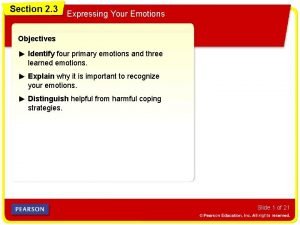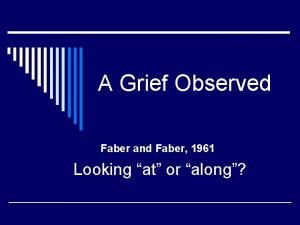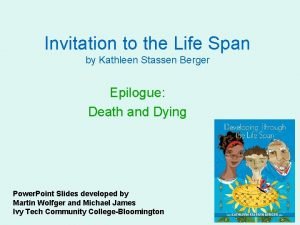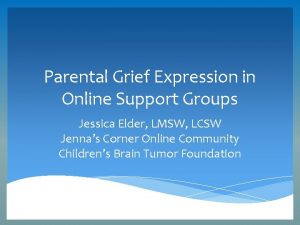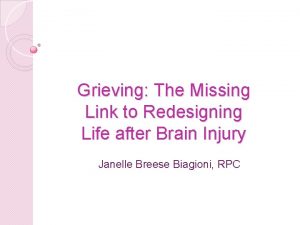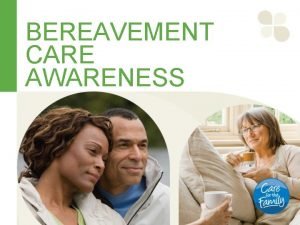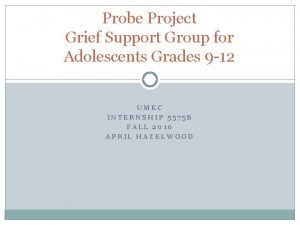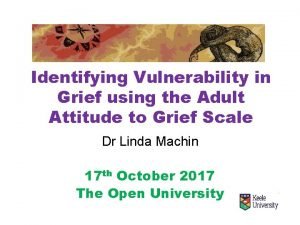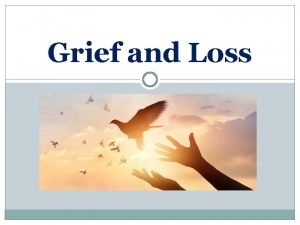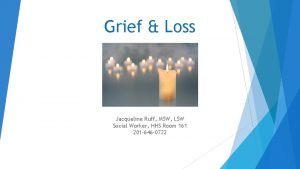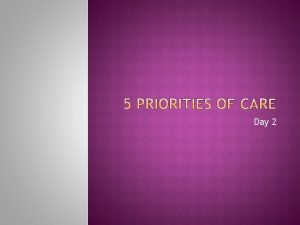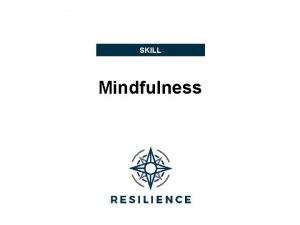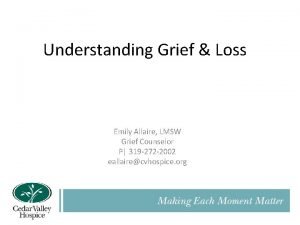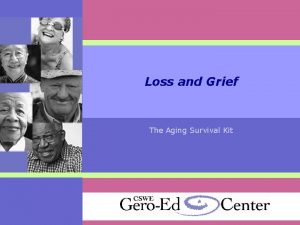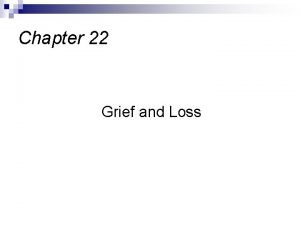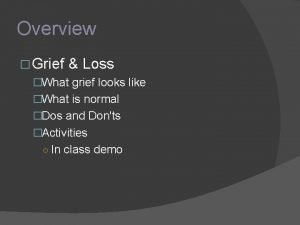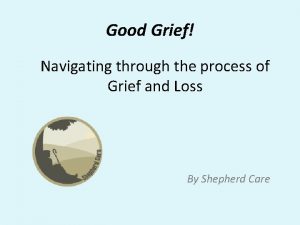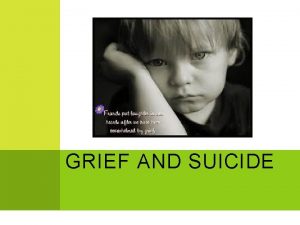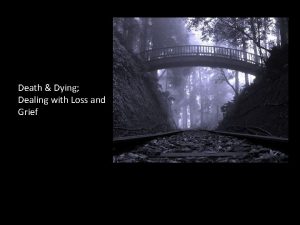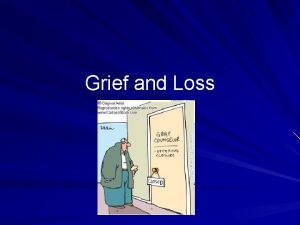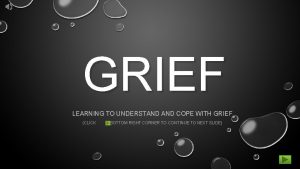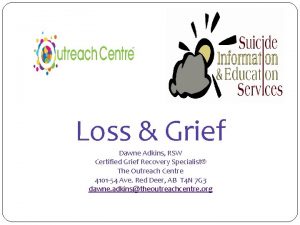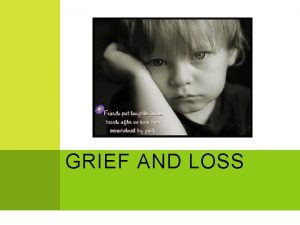Wholly Listening Mindfulness In Supporting Grief Lara Palay

![“[Supporting] spiritual pain is about holy listening rather than compulsive fixing” -Richard Groves and “[Supporting] spiritual pain is about holy listening rather than compulsive fixing” -Richard Groves and](https://slidetodoc.com/presentation_image/3fbde4944c5badaaa72ebfe041c2ab6d/image-2.jpg)


















































- Slides: 52

Wholly Listening: Mindfulness In Supporting Grief Lara Palay, MSW, LISW
![Supporting spiritual pain is about holy listening rather than compulsive fixing Richard Groves and “[Supporting] spiritual pain is about holy listening rather than compulsive fixing” -Richard Groves and](https://slidetodoc.com/presentation_image/3fbde4944c5badaaa72ebfe041c2ab6d/image-2.jpg)
“[Supporting] spiritual pain is about holy listening rather than compulsive fixing” -Richard Groves and Henrietta Klauser

How do individuals with an intellectual/developmental disability grieve losses? In much the same way all people grieve. “The response of people with learning disabilities to bereavement is essentially the same as in non-disabled people. ” (Oswin, 1991) dual diagnoses

It’s important to focus on grief and loss in individuals with an intellectual/developmental disability because it affects their functioning. “There is higher incidence of psychiatric illness following bereavement because of impaired adaptive functioning. ” (Mc. Loughlin, 1986)

Marked behavior and mood changes following death; 50% of pts. with severe behavior problems had loss of a close contact prior to onset; most caregivers minimized or misunderstood reaction (Dodd et al, 2005) Increased likelihood for anxiety and meltdowns in people on the Autism spectrum (Lipsky, 2013)

Do individuals with an intellectual/developmental disability get to participate in healing rituals to deal with grief? Not often. v Only 16% of bereaved clients had opportunity to visit grave or place were ashes were scattered v Only 16% of clients received formal session(s) of bereavement counseling (Hollins et al, 1996)

Rando’s Six Tasks of Grieving

Recognize the loss (avoidance phase) React (confrontation phase) Recollect Relinquish Readjust (accommodation phase) Reinvest

Recognition Individuals may lack opportunities to participate in rituals that facilitate recognition (funerals, viewings, sitting Shiva, mourning clothes, covered mirrors, other outward reminders, etc. ) This may be made worse if others fail to recognize the individuals’ loss (special status of griever, cards/notes)

Recognition Shock may be universal, but different processing styles may also look like shock. Someone on the spectrum may absorb facts quickly, and process and express emotion much more slowly. (Lipsky 2013)

You may also see… Searching: looking out for the person, waiting Bewilderment: wandering, unable to focus Clinging: wanting to be with caretakers all the time Protest: Angry, irritable, acting out Withdrawal: refusal to eat, participate; physical regression (Blackman, 2003)

Emotional Processing Differences Grief may present as: • Burnout • Regression or skill loss • Behavioral challenges • Anxiety • Changes in personality or preferences

Supporting Recognition Participation in family and social events and rituals Encourage flexibility with support people to allow for individual to decide when he or she needs a break, or wants to leave early, etc. Have a back-up plan. If an individual does not want to participate at all, do not force them! Be present for different emotional reactions from family members

Supporting Recognition Participation in family and social events and rituals Staff need flexible scheduling to be able to support individuals outside of typical shifts. Staff need to be aware of their own feelings about what rituals are for and how they “should” go

Stress associated with cultural norms around grieving Increased social-emotional communication demands may increase stress for individuals Without preparation With higher stakes Extra social consequences for missteps Supporters might be grieving and not be at their best. (adapted from Bascom, 2017)

Stress associated with cultural norms around grieving What can staff do? Think ahead Provide concrete instructions and tasks Look for ways we can participate and help others Example: “At this memorial service, could you be in charge of making sure everyone has water if they want it? ”

Communication differences Staff can help ask Does the individual have a script for this? Heightened emotions can be barriers to speech, word-finding, & socialemotional communication (adapted from Bascom, 2017)

Communication differences Staff need to make sure individuals have access to needed vocabulary. Consider using: AAC Scripts Modelling (adapted from Bascom, 2017)

Reacting The individual may lack language for feelings. Family and caregivers may misunderstand that having an I/DD does not prevent understanding and/or feeling the effects of a loss. The first emotion that is expressed may be anger. (Lipsky, 2013)

Reacting 1. I feel… 2. I wish… 3. If I can’t have that wish, I can have…. 4 Today I will… ( Sims, 2002)

Supporting Reacting Normally, expressing feelings are encouraged during this task. However… for someone on the spectrum, it may take longer for them to feel safe and in control enough to explore those feelings.

Supporting Reacting Anger or meltdowns may come from disrupted routines first. Solve the problems logically before asking the person to explore or express feeling. Being concerned with routine and how the loss affects them DOES NOT indicate lack of feeling about the loss or the deceased.

Emotional processing differences Process of grief itself can be unfamiliar & scary. Will I feel like this forever? Need for a map--social stories etc about loss, grief, and the grieving process itself. Need to re-establish norms & parameters Is everyone going to die? How to re-establish safety and construct a new world

Emotional processing differences Some individuals have self-regulation challenges Strong feelings Disrupted routines Scary unknowns Heightened pressure Need for additional support

Recollecting and Re-experiencing This task might be difficult for the individual to work through until concerns about their daily life has been affected have been processed. Mementos may be less of a focus for people on the autism spectrum than others during this phase (Lipsky, 2013).

Recollecting and Re-experiencing The individual also may not be encouraged (or actively discouraged) from talking about the deceased by well -meaning people who do not want to “remind” or upset him or her.

Recollecting and Re-experiencing We have to examine our own fear of not being able to “fix” an individuals feelings, and to tolerate the discomfort of being with someone who is inconsolable.

Supporting Recollecting and Re. Experiencing Everyday stressors can be amplified. Individuals may: temporarily lose abilities or need extra support increase traits and/or challenging behaviors take longer to return to baseline (adapted from Bascom, 2017)

Relinquishing This may be difficult depending on the individual’s developmental stage or understanding of death. Keep information fact-based, and be ready to find completely new routines to avoid confusion and distress. (Lipsky, 2013)

Supporting Relinquishing Explore concepts of death as the individual understands it. Think about questions of self and role: Am I still the (son, daughter, sibling, friend)? Who will love/take care of me? Help the individual to build the skills needed in new environments or with a new conception of self Explore and help the individual to understand the new assumptive world (for example, “Things will not always stay the same, but I can cope with change”)

Be careful with language and euphemism about dying, and encourage family and caregivers to do the same. Expressions like someone “got sick” or “went to sleep” will taken literally, and can cause anxiety and distress (“If I go to sleep, I will die”), or confusion about the permanence of death. When dealing with feelings associated with grief, the individual may tolerate small doses of feelings and not stay deep for very long. Do not underestimate this as not needing to work through emotions. Let the individual dictate the length and pace.

Cognitive strengths as tools for coping with grief & loss Some autistic traits and cognitive strengths can provide important tools for coping with grief and loss. (adapted from Bascom, 2017)

Readjustment The individual may lack support, help with building new skills and understanding new assumptions about the world. He or she may struggle to adapt to real secondary losses related to the role the person played in life, or struggle to adjust to a new environment.

Cognitive strengths as tools for coping with grief & loss Love of ritual & routine Establish rituals for grieving Build new routines to re-establish safety Concrete thinking Arranging objects Places (Bascom, 2017)

Cognitive strengths as tools for coping with grief & loss Sensory thinking Scents Textures Sounds Objects, places Nonverbal processing (Bascom, 2017)

Cognitive strengths as tools for coping with grief & loss Calm through repetition Intense interests as sources of refuge & resilience. (Bascom, 2017)

Reinvestment The individual may be less likely to form significant attachments to others, especially with staff turnover and lack of social connection. This is also challenging if the individual lacks the support and training to build and practice social skills. Finally, lack of support in finding meaning (meaningful work or creation, connection, a narrative for suffering) can make this task hard to complete.

Supporting Reinvestment Encourage efforts to build emotional connections with others Help to find meaningful work, activities or involvement (creative expression, volunteering at charity, involvement in spiritual community) Continue to explore ideas of identity, spirituality and purpose Help to create their own story about the individuals’ suffering (“I am a strong person because of what I’ve been through”, e. g. )

How can staff provide “holy listening”? By wholly listening.

Self-Awareness and Self-Regulation

The Commandments of Feelings 1. 2. 3. 4. 5. They are value-neutral They are transitory They are signals, not problems They may cause feelings in others; that still does not make them problems! They take the time they take and cannot be rushed.

Agencies need specific policies that support individuals and staff. These should provide mechanisms for remembrances and celebratory rituals, staff support including EAP counseling, and recognition of non-bereavement (death) losses. This includes individuals at the end of life.

What else needs to be in place? Intervention as needed for trauma and complicated bereavement (keep in mind that differences in processing and expressing emotion may look like CB but aren’t!)

Remember that losses can come in many forms, including: Separation from family/family home Medically ill parents/caretakers Separation from neighbors and friends Divorce/relationship instability Abandonment by family Isolation because of sexual identity Language/communication barriers

Rituals can be very helpful to explain that a death has occurred, and to assist in expressing and processing feelings.

Some examples of rituals Use of a Plant or Tree Use of Photos of the Death Process Use of Packing Up Belongings Use of a Heart Picture Use of Food (Markell, 2005)

“Grief must be witnessed to be healed” -Elisabeth Kubler-Ross

References and Further Reading American Psychiatric Association, Diagnostic and Statistical Manual of Mental Disorders, 1994. Bascom, Julia from Bascom, Julia and Palay, Lara, LISW-S. “Autism and Grief”. Webinar, The American Association of Intellectual and Developmental Disabilities, 2017. Blackman, Noelle. Loss and Learning Disability. Worth Publishing, 2003. Bowers, Duane, LPC “Trauma, PTSD and Traumatic Grief”, presentation, 2010

Caldwell, Gail. New York Times Book Review, April 15 2011 Dodd et al. “A study of complicated grief symptoms in people with intellectual disabilities”. Jrl of ID Res, May 2008, Vol 52 Part 5, p 415 -425. Gentile, Julie, MD. “Use of Biopsychosocial Formulation in Evaluation of Grief and Loss”, presentation, 2010 Groves, Richard and Klauser, Henriette Anne, The American Book of Dying, Ten Speed Press, 2005

Kubler-Ross, Elisabeth and Kessler, David. On Grief and Grieving. Scribner, 2006. Lipsky, Deborah. How People With Autism Grieve, And How To Help (an Insider Handbook). Jessica Kingsley Publishers, 2013 Markell, Marc. Helping People with Developmental Disabilities Mourn. Companion Press, Center for Loss and Life Transition, 2005 Rando, Therese, Ph. D, Treatment of Complicated Mourning, Research Press, 1993

Sims, Darcie, Ph. D. “What Color is Dead? How to Talk with Kids about Death”. Course manual, Cross Country University training, 2002 Smith, Douglas, Caregiving. Wiley Publishing, 1997 Sobsey, D. Violence and Abuse in the Lives of People with Disabilities: The End of Silent Acceptance? Paul H. Brookes Publishing Co, 1994.

Lara Palay, MSW, LISW-S lara@aldridgepalay. com
 Creo en dios padre todopoderoso
Creo en dios padre todopoderoso Pre listening while-listening and post listening
Pre listening while-listening and post listening While listening stage
While listening stage Lara palay
Lara palay Lara palay
Lara palay Barry sixth form
Barry sixth form Dorethea orem
Dorethea orem Karakteristik teori keperawatan
Karakteristik teori keperawatan Pearson btec health and social care level 3
Pearson btec health and social care level 3 Dorothea orem model
Dorothea orem model Direct investment definition
Direct investment definition Elizabeth orem
Elizabeth orem Mindfulness gyerekeknek
Mindfulness gyerekeknek Mindfulness for collaboration
Mindfulness for collaboration Langer mindfulness scale
Langer mindfulness scale Attention intention attitude
Attention intention attitude Else bisseling
Else bisseling Mindfulness circle
Mindfulness circle Ted talk mindfulness
Ted talk mindfulness Franco fabbro
Franco fabbro Chinese symbol for mindfulness
Chinese symbol for mindfulness Mindfulness definisjon
Mindfulness definisjon Bodily sensations examples
Bodily sensations examples Mind full
Mind full Metakognitive øvelser
Metakognitive øvelser Brainpop precision and accuracy quiz answers
Brainpop precision and accuracy quiz answers Mindfulness
Mindfulness Dhamma
Dhamma Objectives of meditation
Objectives of meditation Active listening passive listening
Active listening passive listening Inferential listening
Inferential listening What was emily dickinson's childhood like
What was emily dickinson's childhood like Chapter 4 lesson 3 coping with loss and grief
Chapter 4 lesson 3 coping with loss and grief Engels model of grief
Engels model of grief The three learned emotions are grief shame and
The three learned emotions are grief shame and Assura inc
Assura inc Assonance in nothing gold can stay
Assonance in nothing gold can stay Grief is like an earthquake
Grief is like an earthquake How does junior cope with his grief
How does junior cope with his grief Psalms for grief
Psalms for grief A grief observed chapter 1
A grief observed chapter 1 Absent grief
Absent grief Grief support
Grief support Ambiguous loss definition
Ambiguous loss definition Grief
Grief Engels 6 stages of grief
Engels 6 stages of grief Tonkin model of grief
Tonkin model of grief Ambiguous grief definition
Ambiguous grief definition Ice breakers for grief support groups
Ice breakers for grief support groups Grief scale for adults
Grief scale for adults It is natural response to loss
It is natural response to loss Grief
Grief Grief wheel
Grief wheel

